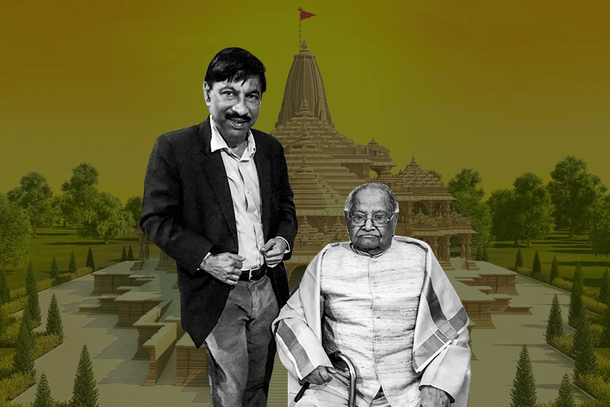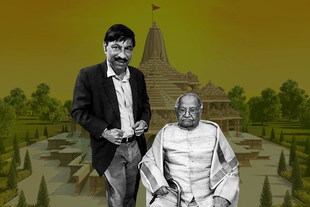Politics
Ayodhya: Why We Should Be Ever Grateful To Dr K.K. Muhammed's Courage
Aravindan Neelakandan
Dec 10, 2023, 10:23 PM | Updated Dec 26, 2023, 06:16 PM IST
Save & read from anywhere!
Bookmark stories for easy access on any device or the Swarajya app.


After the Ayodhya massacres on 30 October and 2 November, 1990, political tensions heightened. On 7 November, five days post the shootings, the V.P. Singh Government lost a vote of confidence and collapsed.
To prevent a potential BJP landslide in immediate elections, Congress sought to delay, counting on Hindu unity dissipating over time, leading to a minority Chandrasekhar Government with Congress support.
Simultaneously, Ashok Singhal declared that kar sevaks would undertake satyagraha. From 6 December, 1990, to 14 January, 1991, numerous kar sevaks practiced satyagraha and courted arrest.
In the same December of 1990, a young archaeologist in the Archaeological Survey of India's Madras office, received a distinguished visitor. Dr. Iravatham Mahadevan, a scholar of many accomplishments—an IAS officer during Nehru's time, a numismatist, epigraphist, and proficient in Sanskrit (both Vedic and classical) and classical Tamil literature and history. He was renowned for his work on Harappan seals and was the editor of Dinamani, He was once an RSS man. But by 1990s, he had moved away from the worldview of the Sangh. He was in principle against correcting the historical wrongs in modern times.
But fiercely honest, he was in support of truth.
He refused to let the Marxist falsehoods about discovering no remains at Ayodhya go unchallenged. During a lecture on December 4, 1990, in Chennai, he highlighted that leftist historians, who denied archaeological proof of the temple's existence, had referenced B.B.Lal's report on the antiquity of human habitation in Ayodhya. However, in that very report, Lal had uncovered evidence of a pillared structure. Subsequently, in the Indian Express, he wrote that if historians still doubted the existence of a temple beneath, such doubt could be dispelled by conducting further excavations.
Dr. K.K. Muhammed who was Deputy Superintending Archaeologist at Madras had read this article. He was part of the team of Prof. Braj Basi Lal which had carried out the excavations in Ayodhya. He was witness to the discovery of a pillared structure beneath the disputed Babri structure.
One of the tallest Muslim politicians of that time, Syed Shahabuddin, had announced that he himself would see to it that Muslims voluntarily hand over the site to the Hindus if Hindus could prove that a temple was indeed demolished to build the domed structure at the controversial site.
Perhaps then here could be a solution. A lot of bloodshed, bitterness between two communities could be avoided.
K.K. Muhammed decided to write a letter to the Indian Express. Yes. There was actually archaeological proof for a structure, a Hindu, non-Islamic structure, under the ‘Babri’ edifice. Muhammed himself was a member of the team of excavations during 1976-77 and he would vouch for the presence of such a structure.
It was this letter that made Mahadevan come to the Chennai office. ‘You are a Government employee’, he pointed out. And you are taking a stand that might not go well with those who are in power and with the equally powerful Marxist scholars. Taking a politically incorrect yet truthful stand may have adverse consequences for you. Are you certain about publishing this letter?
Mahadevan, a firm advocate of speaking truth to power, had even confronted Nehru as a young IAS officer. He supported publishing the letter. However, the young archaeologist, with a promising government career ahead, should be fully aware of the potential consequences of his words.
The duo approached then Superintendent Archeologist B Narasimhayya. It so happened that Narasimhayya was the General Supervisor when the Ayodhya excavations of 1976-77 discovered the brick platform with pillar bases.
'We should not and must not take sides in such an exploding situation', they reckoned. 'But at the same time such an important fact should not be concealed particularly when a powerful motivated group was providing false information to the nation'.
So even though he was actually required to Government permission before writing on such matters, Muhammed decided that he would announce the truth to the nation nonetheless. His letter to Indian Express was published. It was highlighted and published not only in English but in all the regional languages versions of the daily.
This created quite a sensation. Irfan Habib, the supremo of Marxist historians who held a stranglehold on institutions of social science research, was furious. But he could do nothing any more. Truth has ways of coming out. It came out. Not in a shrill voice. But in a voice of scholarship and civility.
'Speak the truth and speak the truth sweetly', that is Sanatana Dharma declares Manu. Dr. K.K. Muhammed had spoken the truth and he had spoken it for the welfare of all. He did not just give his name. He had even given his complete address to Indian Express.
Many in ASI secretly admired K.K. Muhammed's actions, although they couldn't express it openly.
Shortly after the letter's publication, during a UNESCO-sponsored seminar on the silk route in Chennai, the Director General of ASI, MC Joshi, questioned Muhammed in the presence of the Joint Secretary of Culture to the Government of India, Shri RC Tripathi. Dr. Joshi asked Muhammed how, as a government employee, he could make such a public statement without prior permission. He warned of a potential inquiry and suspension.
K.K.Muhammed calmly answered, ‘Lokasamgramevapi sampasyan kartumarhasi’ That was Bhagavad Gita 3:20 – for the sake of the welfare of all humanity one has to do his karma’.
Tripathi got angry at this answer.
K.K.Muhammed smiled and replied: ‘Swadharme nidhanam shreya ...’ That was Bhagavad Gita 3:35. Fortunately, Mahadevan encountered Tripathi and Dr. Joshi soon after. The suspension was downgraded to a mere punishment transfer—to Goa.
Dr. K.K.Muhammed had struck the first blow in a long and systematic series of strikes that would finally demolish the propaganda erected by scholars with vested interests.
This is the seventh piece in the 'Ayodhya 2024' series that Aravindan Neelakandan is writing in the build-up to the inauguration of the Shri Rama Janmabhoomi temple. We will be publishing one article every week. You can read the rest of the pieces in the series here.





